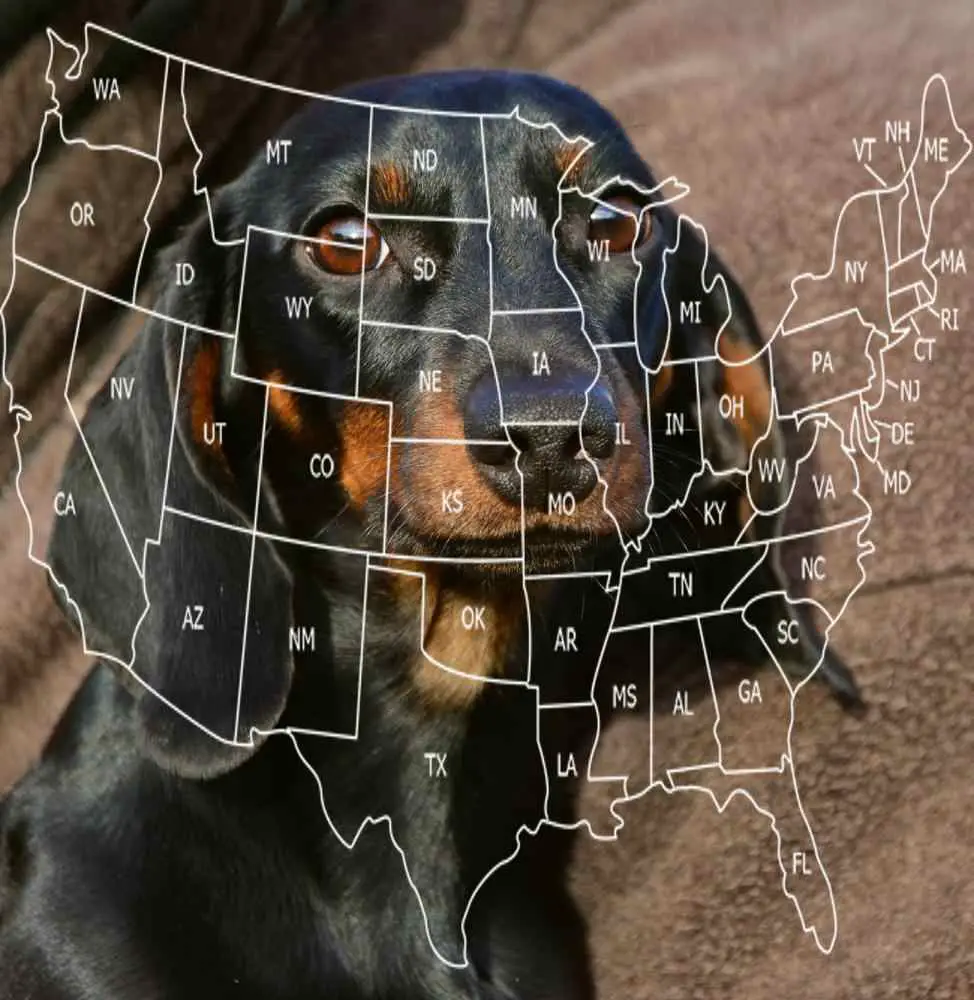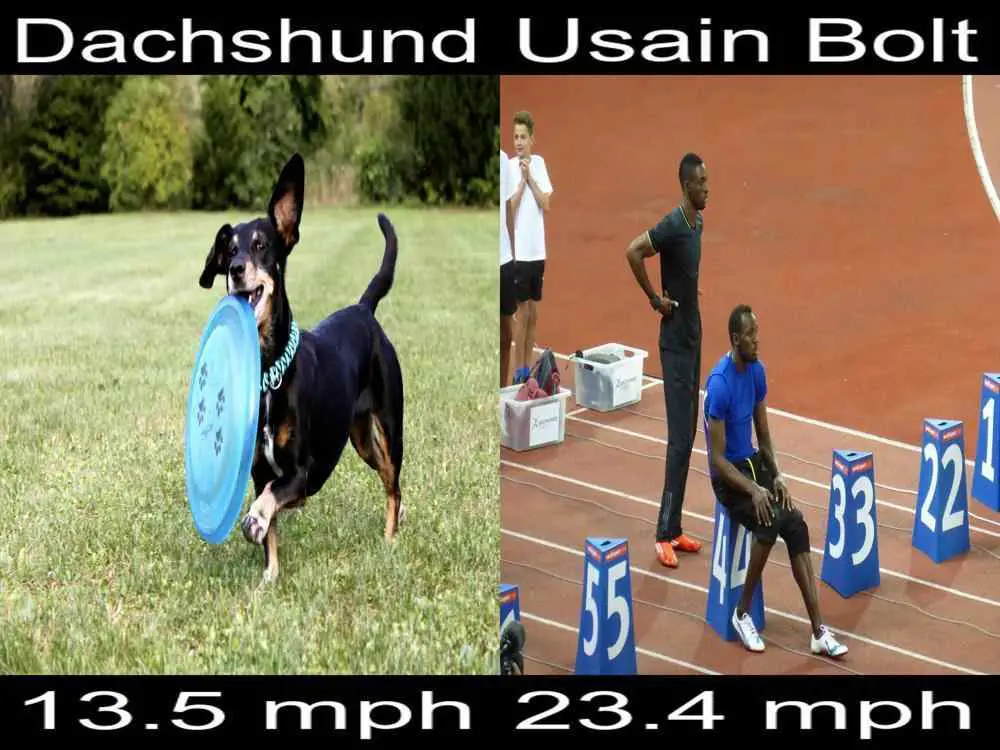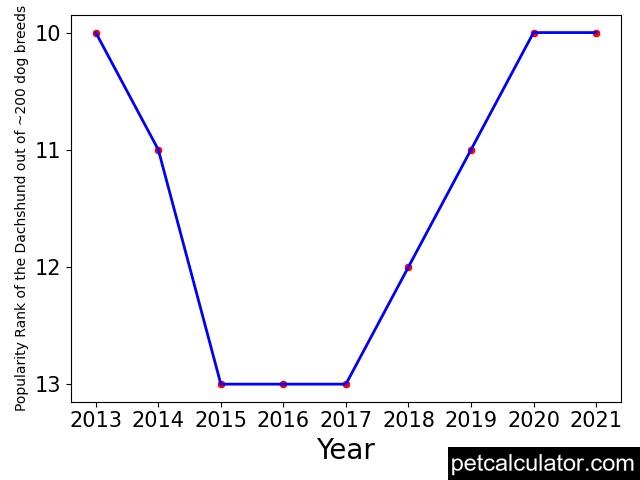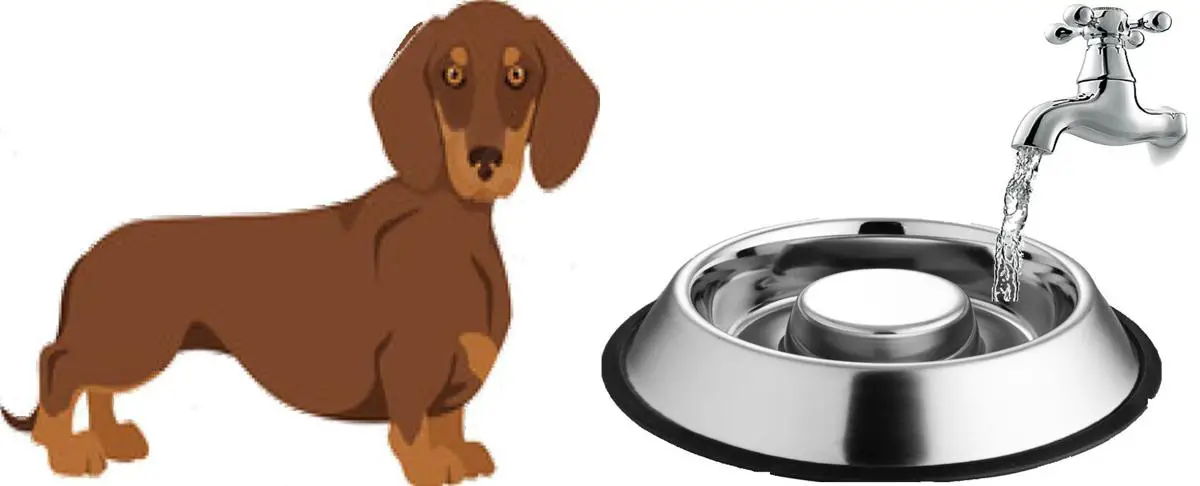Quick Links: Table of Contents
- Dachshund Breed Overview
- History of the Dachshund Breed. Where Dachshunds came from
- What the Dachshund Looks Like
- How Much is the Dachshund Puppy?
- Best Dachshund Breeders
- Adopting or Rescuing the Dachshund
- Dachshund Growth
- The Temperament of the Dachshund
- How Long Dachshunds Live
- Dachshund Litter Size
- How Fast Dachshunds Can Run
- Good Names for Dachshunds
- How Intelligent are Dachshunds?
- How Popular are Dachshunds with New Dog Owners?
- Health Problems in Dachshunds and How to Prevent Them
- How to Take Care of Dachshund
- Dog Breeds That Are Similar to Dachshunds
- Other Things to Know About Dachshunds
Dachshund Breed Overview
The Dachshund is a tiny-sized dog.
The adult Dachshund stands 8 inches to 9 inches tall at the shoulder.
The Dachshund belongs to the Hound Dogs group.
Dogs in the Hound Dogs group, like the Dachshund, were bred to pursue and hunt warm-blooded animals. Hounds hunt by using their good sight or their good sense of smell. Dogs that belong to the Hound Group have strong prey drives and often will stop at nothing to catch what they are pursuing.
The fact that the Dachshund belongs to the Hound Dogs group is one of the reasons why Dachshunds have the personality and temperament that they have.
The temperament of the Dachshund is generally described as:
- Active
- Clever
- Courageous
- Devoted
- Independent
- Lively
- Playful
- Stubborn
History of the Dachshund Breed. Where Dachshunds came from
Hundreds of years ago, the dachshund was bred to hunt badgers in Germany.
“Dach” is a badger name, and “hund” is a dog name.
There were three types of dachshunds: smooth-, wire, and long-coated.
They all originated at different times.
The first was smooth.
It was a mix of a miniature French pinscher and a pinscher.
There are two sizes of the dachshund: the miniature is the original, while the standard is the smaller.
The dachshund`s short, strong legs allow it to dig out prey and get into burrows.
The dachshund was bred to chase deer and fox.
For hunting ferrets and hares, smaller dachshunds are bred.
Although the breed is still used in Europe for hunting, it is now a common family pet in North America.
It is one of the most loved AKC breeds.
.
What the Dachshund Looks Like
There are two sizes of all three types of dachshunds: the standard and mini.
The long, muscular legs and short backs of all three types make them unflatteringly known as “sausage dog” or “hot dogs”.
The dachshund also has a long muzzle and long, droopy ears.
Their tail is also in line with their back.
The coat of a dachshund can be colored in various colors, including black, chocolate, white, or gray.
Some dachshunds have spotted or dappled spots or tan marks.
.
How Much is the Dachshund Puppy?

The average price of a Dachshund puppy is $1730. The price of a Dachshund puppy ranges from $1000 to $2000.
A lot of factors determine the price of the Dachshund. These factors include what health records the Dachshund puppy has, the lineage of the Dachshund puppy, the US state the breeder is located in, etc.
To estimate how much you can expect to pay for a puppy Dachshund based on the many factors that determine the price of the Dachshund puppy, check out our calculator that lets you estimate how much you should expect to pay for the Dachshund puppy based on what you want in the puppy.
When looking to buy a puppy, look at buying a puppy only from well-established breeders that breed puppies primarily for the love of the Dachshund breed, and secondarily for profit. Do not buy a puppy from a puppy mill. Puppy mills mass-produce puppies in bad living conditions for maximum profit.
You may also consider adopting instead of buying a puppy. Adoption costs are very low compared to the price of a puppy.
Best Dachshund Breeders

We have researched reputable Dachshund breeders that you can buy a puppy.
Go to this page for our complete list of reputable Dachshund breeders in various states in the United States.
On this page, you will see how much these breeders sell their puppies for, and how many puppies they have available.
A few of these breeders are listed below.
Jo-Ruth Strange
Puppy Price: Check with breeder
Merrywind Teckels
Puppy Price: $1300
Bravehart Dachshunds
Puppy Price: Check with breeder
Doxielubber Miniature Dachshunds
Puppy Price: Check with breeder
Rebecca Sohl
Puppy Price: $1700 -$ 1800
Adopting or Rescuing the Dachshund
You may consider adopting a dog instead of buying a puppy. Many dogs, Dachshunds included, are currently available for adoption in your local dog shelters.
These helpless but adorable dogs are waiting in dog shelters hoping that someday someone will rescue them. Dog adoption costs are lesser than the cost of a new puppy. Dog adoption costs are usually around $300 or even less.
In addition to your local dog shelter, another good place to find dogs that are available for adoption is petfinder.com.
Below is an adorable Male Dachshund named Ranger that is currently available for adoption on Petfinder.com. You can find other lovely Dachshunds like Ranger on pefinder.com.

Sam is the name of another Dachshund (Male) on petfinder.com that is looking for a new forever home.

You can find more Dachshunds that are available for adoption on petfinder.
Dachshund Growth

New Dachshund owners need to know about the growth of their Dachshunds. This will help them plan their living spaces accordingly.
Also, knowing the typical growth pattern of the Dachshund will help new owners catch the abnormal growth of their Dachshund early.
See our calculator for predicting how big your Dachshund puppy will get. You will also learn about the typical weight of the Dachshund at different ages and how to catch abnormal growth in your Dachshund


The Temperament of the Dachshund
The temperament of the Dachshund based can be summarized as in the table below.
The table shows the scores of the Dachshund for 13 important dog behavioral factors.
We obtained these scores by analyzing raw data from the C-BARQ dog personality survey tool. The higher the score of a dog for a factor, the worse the temperament of the dog regarding that factor.
The C-BARQ tool was developed by researchers from the University of Pennsylvania, and it is a scientific tool that is used worldwide for reliably measuring the temperament of dog breeds.
See our complete analysis of the temperament of the Dachshund here.
| Factor | Score |
|---|---|
| Stranger Directed Aggression | 91.3 percent |
| Dog Directed Aggression | 81.3 percent |
| Attachment Attention Seeking | 68.7 percent |
| Separation Related Behavior | 66.2 percent |
| Stranger Directed Fear | 62.5 percent |
| Dog Directed Fear | 62.1 percent |
| Energy Level | 59.3 percent |
| Excitability | 59.1 percent |
| Prey Drive | 57.5 percent |
| Stubbornness | 53.4 percent |
| Dog Rivalry | 51.7 percent |
| Nonsocial Fear | 45.3 percent |
| Touch Sensitivity | 42.9 percent |
| Owner Directed Aggression | 40.0 percent |

How Long Dachshunds Live
The lifespan of the Dachshund is typically from 12 to 15 years.
Moreover, a few years back, veterinarian researchers performed a scientific study to determine the lifespan of the Dachshund. In this study, the scientists collected data on how long 245 pet Dachshunds lived.
From the study, it was found that Dachshunds have an average lifespan of 12.6 years. Furthermore, the study found that it is not uncommon for Dachshunds to live as long as 19 years.
Note that you need to put in some effort if you want your Dachshund to live long.
Dachshunds live long if they eat well, drink well, exercise well, and visit the veterinarian regularly.
There are also dog supplements that you can give your Dachshund to improve your Dachshund`s quality of their life.
Click here to learn more about how to make your Dachshund live long.

Dachshund Litter Size
Researchers from the Norwegian School of Veterinary Science did a study where they counted the numbers of puppies in 358 different Dachshund birth litters.
From this study, the researchers found that the average number of puppies that Dachshunds can have is 5 puppies. Also, the Dachshund can have as few as 1 puppies per litter and as many as 13 puppies per litter.
The number of puppies that the Dachshund will have depends on factors such as the age of the Dachshund, the method of pregnancy, etc.
Click here to see our calculator for predicting how many puppies your Dachshund will have and how the litter size of the Dachshund compares to the litter size of other dog breeds.
How Fast Dachshunds Can Run

How fast a dog breed can run is a good measure of how athletic the dog breed is.
The American Kennel Club (AKC) regularly conducts dog running competitions. The AKC records the running speed of competing dogs in these competitions. These competitions are open to all dog breeds.
Based on our analysis of the speeds of 269 different Dachshunds, the average speed of the Dachshund is 13.5 mph (21.7 kmph).
The fastest speed on AKC record that the Dachshund ran in a race is 22.17 mph (35.7 kmph) and the minimum speed on record in a race for a Dachshund is 2.89 mph (4.7 kmph).
Click here to see how the speed of the Dachshund compares to the speed of other dogs and other mammals such as cats, horses, humans, etc.

Good Names for Dachshunds
Here are some really good names that are typical for the Dachshund ranked by popularity:
- Max
- Oscar
- Sammy
- Shadow
- Rusty
- Rummy
- Tucker
- Coney
- Noodles
- Easley

How Intelligent are Dachshunds?
| Dachshund | |
|---|---|
| Intelligence Rank | 49 out of 130 dog breeds |
| Trainability | Tend To Learn New Commands After 25 To 40 Repetitions |
According to Prof. Stanley Coren, a Canadian psychology professor/dog trainer, the total intelligence that a dog demonstrates is the addition of three types of intelligence. These intelligence types are:
- Instinctive Intelligence: This is the natural intelligence that comes from instinct. For example, dog breeds that have been historically bred to be guard dogs will have a high `guarding` intelligence compared to dogs that were not bred for guarding.
- Adaptive Intelligence (learning and problem-solving ability): This indicates what a dog can learn to do for himself or herself. Adaptive intelligence is specific to each dog, and not breed specific. You can improve your dog`s adaptive intelligence by investing time to train your dog.
- Working/Obedience Intelligence: This type of intelligence is breed-specific. Certain dog breeds tend to have higher working/obedience intelligence than some other breeds. This intelligence is the closest to what we might call school-learning ability and it is based upon what the dog can learn to do when instructed by humans. This type of intelligence can be measured for each dog breed and compared to that of other dog breeds.
Professor Stanley Coren measured and ranked the working intelligence of about 130 different dog breeds.
Prof. Coren found that the Dachshund has an obedience intelligence rank of 49 out of 130 dog breeds. Thus, Prof. Coren put Dachshunds in the `Average Working/Obedience Intelligence Dogs` category.
This means that Dachshunds tend to learn new commands after 25 to 40 repetitions.
However, we should mention that a dog should not be judged based on its intelligence alone. There are other important factors you need to consider when deciding on which dog breed to get. These other factors include sociability, adorability, and compatibility of the dog breed with your lifestyle.
See the intelligence ranking of some other dog breeds below:
| Breed | Intelligence Rank |
|---|---|
| German Shepherd Dog | 3 |
| Shetland Sheepdog | 6 |
| Belgian Sheepdog | 15 |
| German Shorthaired Pointer | 17 |
| Cocker Spaniel | 20 |
| Pomeranian | 23 |
| Giant Schnauzer | 28 |
| American Staffordshire Terrier | 34 |
| American Foxhound | 46 |
| French Bulldog | 58 |
| Italian Greyhound | 60 |
| Old English Sheepdog | 63 |
| Great Pyrenees | 64 |
| Bull Terrier | 66 |
| Chihuahua | 67 |
| Lhasa Apso | 68 |
| Beagle | 72 |
| Pekingese | 73 |
| Basenji | 78 |
| Afghan Hound | 79 |

How Popular are Dachshunds with New Dog Owners?
Every year, the American Kennel Club (AKC) publishes information on how popular a dog breed is in that particular year. The AKC gets the popularity information of a breed from how many dogs of that breed the owners register with the AKC every year. The AKC collects this data for about 200 dog breeds.
The graph below shows the popularity trend of the Dachshund.
The popularity of the Dachshund averaged over the years is Number 11 out of about 200 dog breeds.

Do not get a dog breed just because it is a popular dog breed. And do not reject a dog breed just because it is an unpopular breed.

Health Problems in Dachshunds and How to Prevent Them
Every dog breed has its own set of health problems that it tends to develop. There is nothing like a perfect dog breed.
The Dachshund is prone to certain genetic health conditions. The Orthopedic Foundation for Animals (OFA) is an organization that keeps track of genetic health problems in dog breeds.
From the extensive records that the OFA keeps, the OFA knows what health problems each dog breed is naturally prone to develop.
Hence, the OFA recommends which health screening breeders should perform on a dog breed to make sure that the breeders won`t breed `defective` dog parents that can pass down defective genes to their puppy offspring.
If you want a Dachshund puppy that will grow up to be healthy, make sure that your Dachshund breeder screens your puppy or your puppy`s parents for the health problems that the OFA recommends for your puppy`s breed. This will increase the chances that your puppy is free from genetic defects.
The following are the health tests that Orthopedic Foundation for Animals (OFA) recommends that breeders should screen Dachshunds for:
- Autoimmune thyroiditis
- Congenital Deafness
- Eye Examination
- Patellar Luxation
- Progressive Retinal Atrophy
You can find out more about OFA`s recommended tests for Dachshunds here.

How to Take Care of Dachshund
To take good care of your Dachshund, you need to make sure that you groom your Dachshund regularly.
Secondly, you need to find a veterinarian in your area that will routinely check the health status of your Dachshund regularly, and give you appropriate recommendations on your Dachshund`s preventative care.
Thirdly, you need to commit some time to exercise your Dachshund daily. Regular exercise helps improve the health and quality of life of your Dachshund.
Also, you need to feed your Dachshund high-quality dog food, and the food should be of the right amount to prevent your Dachshund from getting overweight or underweight.
See our recommendations on what to feed the Dachshund and how much food to feed the Dachshund at different life stages.
Finally, you need to make sure that your Dachshund has access to clean water all the time. See our recommendations on how much water your Dachshund needs to drink at different ages.
Dog Breeds That Are Similar to Dachshunds
If you have not made up your mind on which dog breed to get, you may also want to consider some other dogs similar to the Dachshund.
We crunched the numbers and found that the following dog breeds that have similar behavior and temperament as the Dachshund:
- Dandie Dinmont Terrier (71 percent match with Dachshund). Learn more about the Dandie Dinmont Terrier here.
- Lhasa Apso (71 percent match with Dachshund). Learn more about the Lhasa Apso here.
- Manchester Terrier (75 percent match with Dachshund). Learn more about the Manchester Terrier here.
- Miniature Pinscher (72 percent match with Dachshund). Learn more about the Miniature Pinscher here.
- Pomchi (70 percent match with Dachshund). Learn more about the Pomchi here.

Other Things to Know About Dachshunds
Here are some of the very important characteristics of the Dachshund that you need to know about the Dachshund breed:


